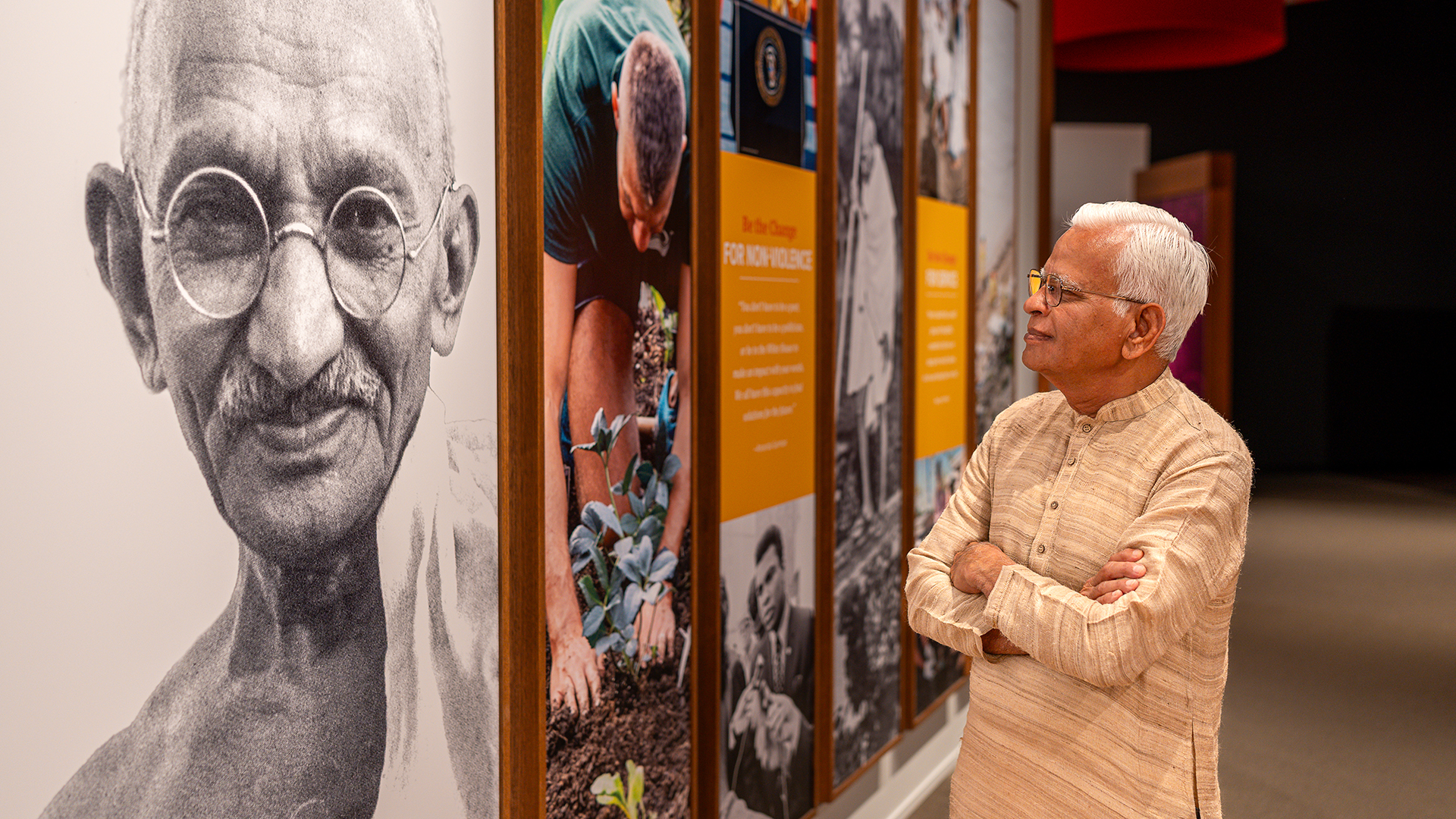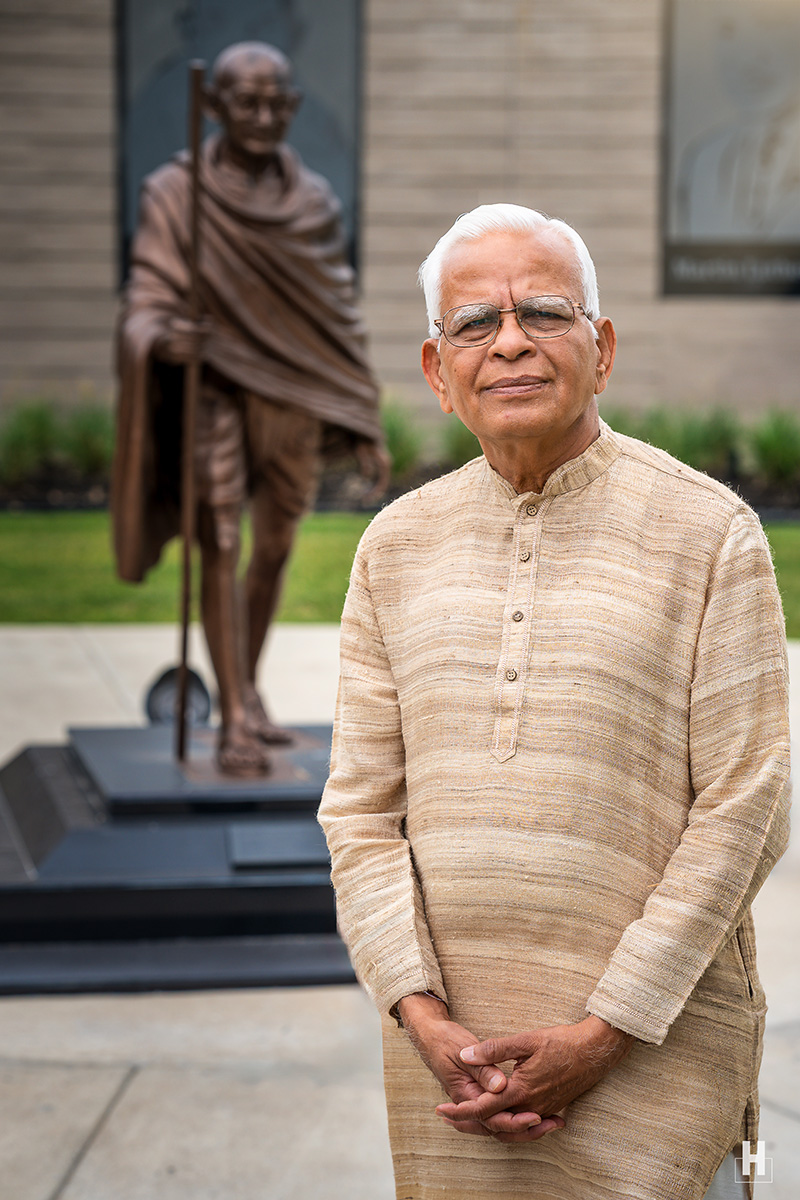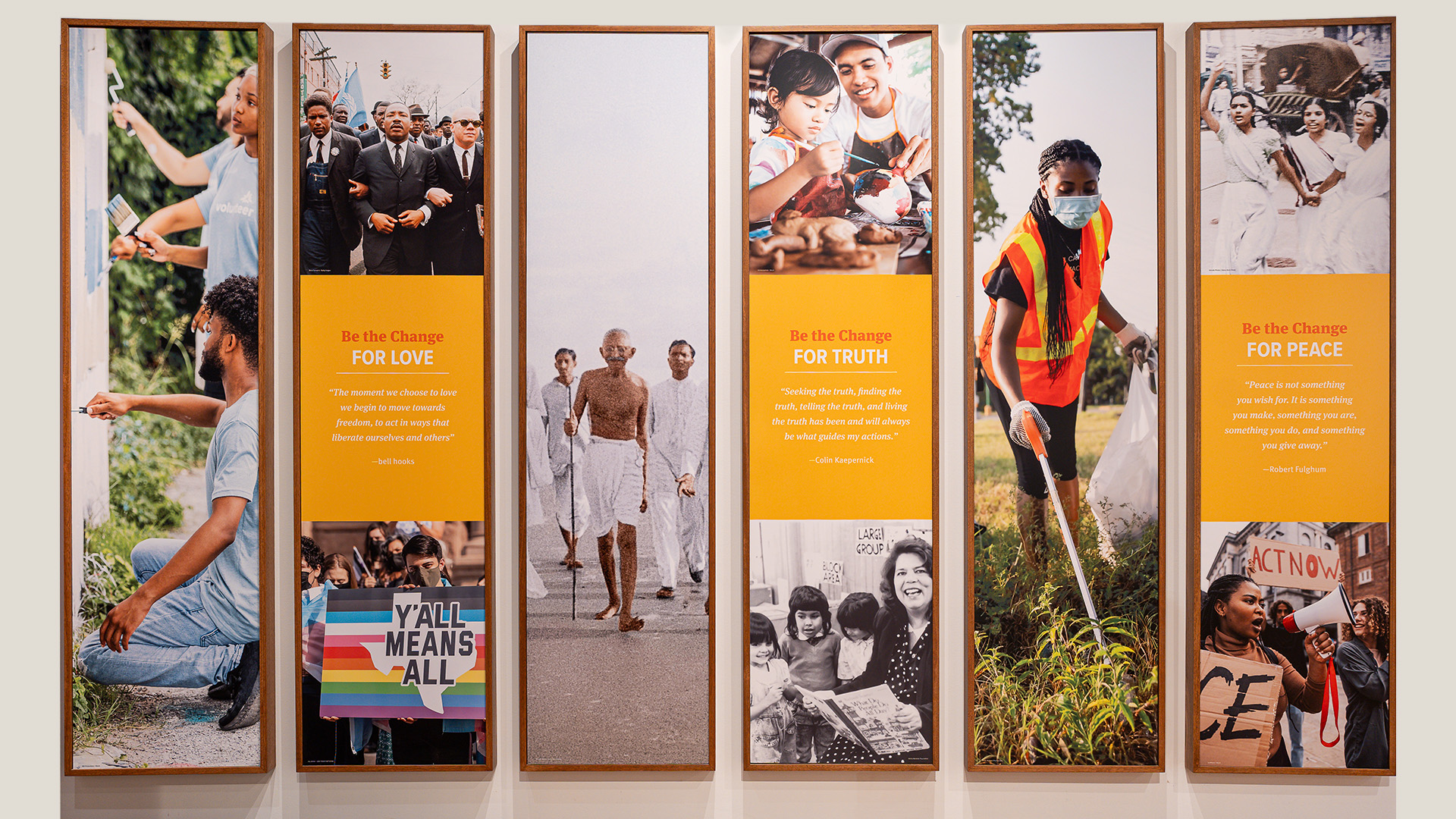By Andrew Dansby, HoustonEndowment.org contributor
The Eternal Gandhi Museum Houston welcomes visitors with a familiar image just outside its front door: A bronze statue of Mahatma Gandhi clad in a dhoti and a khadi, striding with lathi in hand. The museum bends into an arc around him, a semicircle dotted with plaques honoring five Nobel Peace Prize recipients who carried on his commitment to nonviolent resolution: Rev. Martin Luther King Jr., Betty Williams, Mairead Corrigan Maguire, Lech Walesa, and Nelson Mandela.
The design of the Eternal Gandhi Museum Houston is fitting. It begins with that familiar visual—an iconic historical figure—and ends with a fuller story about a life lived simply but profoundly. It starts with a single person and ends with a movement.
The museum is a vivid example of Houston Endowment’s efforts to strengthen the region’s arts and culture ecosystem by investing in effective mid-sized organizations that are deeply rooted in community. By nurturing a relationship across seasons of growth, starting with feasibility studies and capital building, then evolving into operating support, Houston Endowment gave the organization time to find its feet.
“The museum had the potential to be educational, to create engagement,” said Bao-Long Chu, program director for Arts & Culture and Greenspaces at Houston Endowment. “Those are priorities for Houston Endowment. We saw its potential as a learning space for young people, and saw the potential for this giving approach to reflect an increasingly diverse city back to itself through art, culture, and education.”
As the first museum in the Western Hemisphere dedicated to Gandhi, a transformative 20th-century figure whose teachings remain a work in progress for a world in conflict, the center opened on three acres southwest of downtown Houston in 2023.
Its arrival was years in the making, the result of passionate, curatorial, and financial forces that brought it into being. It started with Atul Kothari, who said he took to heart Gandhi’s challenge: “Be the change you wish to see.”
A shadowbox near the museum’s exit contains replicas of Gandhi’s only possessions at the time of his death. They number fewer than 10, including eyeglasses, sandals and prayer beads, the few core fundamental objects through which he experienced the world.
“We wanted to keep our focus on Mahatma Gandhi,” he said, “and the principles he used to resolve conflict nonviolently. It’s unfortunate but true: We need them very much today.”
Kothari envisioned a steady flow of school buses carrying students to the museum. Houston Endowment recognized the opportunity to provide early access to the arts and build new audiences for the sector.
Looking to the past to create a better future

Kothari’s idea had a following, and the timing was right. The U.S. Census Bureau reported an increase of more than 80 percent in residents of Asian descent in Fort Bend County between 2010 and 2020. He and a Board of Trustees thought a proper museum was the next step. They just didn’t have a plan for making it happen.

Kothari grew up in Sabarmati, a suburb in Ahmedabad in India. He traveled to the United States for college in the 1970s. Here, more than a quarter century later, he took Gandhi’s teachings to heart and started the Mahatma Gandhi Library, which, despite the name, was less a book repository and more an organization dedicated to celebrating Gandhi’s life and teachings. By 2004, the library had initiated a Mahatma Gandhi Week in celebration. Two years later, the library oversaw the 1,000 Lights for Peace, a celebratory lighting of candles at Houston’s City Hall that became an annual tradition. The Gandhi Library also oversaw entertainment events that took place at Miller Outdoor Theatre.
Chu joined Houston Endowment in 2015. A year later, he and Kothari discussed the Gandhi Library and the idea of building a museum.
“It was pretty much a dream. But Atul was so passionate about creating this entity here in Houston,” Chu said. “I was mesmerized by his passion, and the concept aligned with Houston Endowment’s vision for the arts sector. We talked about building a museum not as a shrine but as something different—a place to learn about this incredible life and his effect on the world.”
Kothari visited the Gandhi Museum in New Delhi in 2016. There, he was offered access to interactive exhibits about Gandhi’s life IF he could create a dedicated space to house them. With Houston Endowment’ support, the Gandhi Library was about to transform from an idea into a physical structure, the first space of its kind outside of India.
Kothari’s needs were panoramic: financial, curatorial, aesthetic, practical. Houston Endowment stepped in to assist with all of them. The Foundation connected the new Eternal Gandhi Museum to Brian Crockett, an experienced museum consultant with the Texas Association of Museums, a longtime grantee.
By 2018, a vision and a sustainable plan was in place to create a physical space. Crockett connected the museum with Solid Light, a Louisville, Kentucky-based design company that would shape the look of the space and establish a vision for the narrative it wished to tell.
The Eternal Gandhi Museum in New Delhi donated $500,000 in multimedia exhibits and granted exclusive rights for the first and only Eternal Gandhi Museum in North America. India’s government donated the bronze statue. And in August 2023, the Eternal Gandhi Museum Houston opened its doors to tell a story of resilience and resistance. A ribbon-cutting ceremony took place two months later with Gandhi’s grandson and the nephew of Martin Luther King Jr. in attendance.
Telling the cultural story of Houston
The museum treats Gandhi’s story not as deep history but rather living history. Visitors find in the lobby a gallery about Humanity’s Challenges: poverty, violent conflict, pollution, issues of class and labor.
Though the Eternal Gandhi Museum resides 15 miles from Houston’s much-celebrated Museum District, it nestles alongside other institutions that tell the cultural story of a city. With more than 150,000 Indian-Americans living in the Houston area, according to Pew Research, the city had a foundational interest in a space like the Eternal Gandhi Museum.
The space also fits Houston Endowment’s transformative mission: Jesse H. Jones and Mary Gibbs Jones started the Foundation in 1937 with the intention of creating “a vibrant community where all residents have the opportunity to thrive.”
The shape of the Eternal Gandhi Museum sweeps with intent. Among the more profound of Gandhi’s few possessions was the Charkha Wheel, which he began using regularly upon his return to India from South Africa in 1914. The mechanism spins fibers into yarn. For Gandhi, using the Charkha was a source of meditative energy. It also served a symbolic purpose: an act of creation and self-sufficiency.
Gandhi also during his life developed a framework for society, the oceanic circle, which did away with pyramidal hierarchy. The semi-circular shape is a nod to his oceanic concept but it also calls on visitors to transform into participants in the work Gandhi began. The museum emphasizes its role as an education center, offering Gandhi’s life and philosophies as an introduction as well as an invitation for others to be swept up by his commitment to nonviolent conflict resolution.
The final gallery in the Eternal Gandhi Museum completes the circle. The space is one for reflection and inspiration as visitors are urged to commit themselves to creating positive and peaceful change in their communities. They are urged to leave the museum and go back into the world inspired to make it better. To be, as Gandhi encouraged, the change they wish to see.
